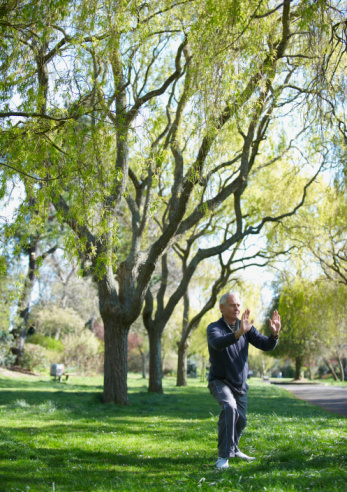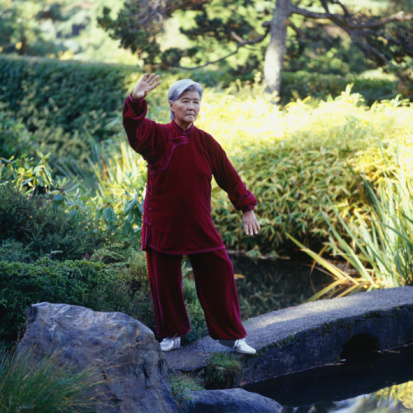Jindao Life Transforming Energy Healing Theory
by Salvatore Canzonieri
NEW! Qigong Book available with information on healing, purifying, and manifesting.
Click here for more information
The Jindao System converges various theories that address the nature of humanity and its relationship to the universe, in order to provide 'Natural Energetic Healing' for the body, mind, and spirit.
The most important ideas, among others, in the Jindao System are: "It's not what you want, but what you got"; "You have to give in order to get"; "The Universe is Giving / Loving Energy, the Earth is Receiving / Accepting Energy, and Humanity is the Union of both", which arise from the very ancient philosophies of Taoism, Chan (Zen) Buddhism, Christian Mysticism, Kaballism, and Tantra.
Taoism
The word Tao (or Dao , depending on the romanization scheme), literally translates as "path" or "way" (of life) and can figuratively mean "essential nature", "destiny", "principle", or "true path".
Taoist propriety and ethics emphasize the Three Jewels of the Tao : compassion, moderation, and humility, while Taoist thought generally focuses on nature; the relationship between humanity and the cosmos; health and longevity; 'Wu Wei' (action through inaction), which is thought to produce harmony with the universe; emptiness (refinement), detachment , flexibility, receptiveness, spontaneity, the relativism of human ways of life, ways of speaking and guiding behavior.
Tao can be roughly stated to be the flow of the universe, or the force behind the natural order, equating it with the influence that keeps the universe balanced and ordered. The flow of Qi , as the essential energy of action and existence, is often compared to the universal order of Tao.
Tao is also associated with the complex concept of De - "power; virtue; integrity", that is, the active expression of Tao.
Wu wei is a central concept in Taoism. The literal meaning of wu wei is "without action". It is often expressed by the paradox wei wu wei , meaning "action without action" or "effortless doing". The practice and efficacy of wu wei are fundamental in Taoist thought. The goal of wu wei is alignment with Tao, revealing the soft and invisible power within all things. It is believed by Taoists that masters of wu wei can observe and follow this invisible potential, the innate in-action of the Way.
In ancient Taoist texts, wu wei is associated with water through its yielding nature. Water is soft and weak, but it can move earth and carve stone. Taoist philosophy proposes that the universe works harmoniously according to its own ways. When someone exerts his will against the world, he disrupts that harmony. Taoism does not identify man's will as the root problem. Rather, it asserts that man must place his will in harmony with the natural universe.
P'u represents this passive state of receptiveness. P'u is a symbol for a state of pure potential and perception without prejudice. In this state, Taoists believe everything is seen as it is, without preconceptions or illusion.
P'u is usually seen as keeping oneself in the primordial state of tao. It is believed to be the true nature of the mind, unburdened by knowledge or experiences. In the state of p'u , there is no right or wrong, beautiful or ugly. There is only pure experience, or awareness, free from learned labels and definitions. It is this state of being that is the goal of following wu wei.
Taoists believe that man is a microcosm for the universe. The body ties directly into the Chinese five elements. The five organs correlate with the five elements, the five directions and the seasons. Akin to the Hermetic maxim of " as above, so below ", Taoism posits that man may gain knowledge of the universe by understanding himself.
In Taoism, various rituals, exercises, and substances are said to positively affect one's physical and mental health. They are also intended to align oneself spiritually with cosmic forces, or enable ecstatic spiritual journeys. Internal alchemy and various spiritual practices are used by some Taoists to improve health and extend life, theoretically even to the point of physical immortality.
The Three Jewels, or Three Treasures, (san-bao) are basic virtues in Taoism. The Three Jewels are compassion, moderation, and humility. They are also translated as kindness, simplicity (or the absence of excess), and modesty.
Chan (also known as 'Zen') Buddhism was particularly modified by Taoism, integrating distrust of scripture, text and even language, as well as the Taoist views of embracing "this life", dedicated practice and the "every-moment".
Chan or Zen Buddhism
Chan is a school of Mahayana Buddhism, translated as Zen in Japanese. Chen is in turn derived from the Sanskrit dhyana , which means " meditation ". Chan or Zen emphasizes experiential prajña, particularly as realized in the form of meditation, in the attainment of enlightenment . As such, it de-emphasizes theoretical knowledge in favor of direct, experiential realization through meditation and dharma practice. The establishment of Chan / Zen is traditionally credited to be in China, the Shaolin Temple, by the South Indian Pallava prince-turned-monk Bodhidharma, who came to China to teach a "special transmission outside scriptures" which "did not stand upon words".
Through Chan / Zen there developed a way that concentrated on direct experience rather than on rational creeds or revealed scriptures. Wisdom was passed, not through words, but through a lineage of one-to-one direct transmission of thought from teacher to student.
Some scholars also argue that Chán has roots in yogic practices, specifically kammatthana , the consideration of objects, and kasina , total fixation of the mind. Many historians proposed that Chán was probably an indigenous Chinese creation by mixing Buddhist doctrine with Daoist and Neo Daoist ideas. Some Chinese scholars, such as Ma Tian Xiang even propose that Zen's foundation is based on Lao Zhuang Daoist philosophy instead of Indian Buddhism.
Zen asserts, as do other schools in Mahayana Buddhism, that all sentient beings have Buddha-nature , the universal nature of inherent wisdom (Sanskrit prajna ) and virtue, and emphasizes that Buddha-nature is nothing other than the nature of the mind itself. The aim of Zen practice is to discover this Buddha-nature within each person, through meditation and mindfulness of daily experiences. Zen practitioners believe that this provides new perspectives and insights on existence, which ultimately lead to enlightenment.
Unlike other Buddhist sects, Zen de-emphasizes reliance on religious texts and verbal discourse on metaphysical questions. Zen holds that these things lead the practitioner to seek external answers, rather than searching within themselves for the direct intuitive apperception of Buddha-nature. This search within goes under various terms such as “introspection,” “a backward step,” “turning-about,” or “turning the eye inward.”
Zen Buddhists may practice koan inquiry during sitting meditation (zazen ), walking meditation, and throughout all the activities of daily life. Koans often appear to be paradoxical or linguistically meaningless dialogues or questions. But to Zen Buddhists the koan is "the place and the time and the event where truth reveals itself". Answering a koan requires a student to let go of conceptual thinking and of the logical way we order the world, so that like creativity in art, the appropriate insight and response arises naturally and spontaneously in the mind.
There are other techniques common in the Zen tradition which seem unconventional and whose purpose is said to be to shock a student in order to help him or her let go of habitual activities of the mind. Some of these are common today, while others are found mostly in anecdotes. These include the loud belly shout known as katsu . It is common in many Zen traditions today for Zen teachers to have a stick with them during formal ceremonies which is a symbol of authority and which can be also used to strike on the table during a talk.
Thomas Merton (1915–1968) the Trappist monk and priest was internationally recognized as having one of those rare Western minds that was entirely at home in Asian experience. Like his friend, the late D.T. Suzuki , Merton believed that there must be a little of Chan / Zen in all authentic creative and spiritual experience. The dialogue between Merton and Suzuki explores the many congruencies of Christian mysticism and Chan / Zen.
Christian Mysticism
Christian mysticism is the pursuit of communion with, identity with, or conscious awareness of God through direct experience, intuition, instinct or insight. Christian mysticism usually centers on a practice or practices intended to nurture those experiences or awareness, such as deep prayer (i.e. meditation, contemplation ) involving the person of Jesus Christ and the Holy Ghost . This approach and lifestyle is distinguished from other forms of Christian practice by its aim of achieving unity with the divine.
Whereas Christian doctrine generally maintains that God dwells in all people and that they can experience God directly through belief in Jesus, Christian mysticism aspires to apprehend spiritual truths inaccessible through intellectual means, typically by learning how to think like Christ. William Inge divides this scala perfectionis into three stages: the "purgative" or ascetic stage, the "illuminative" or contemplative stage, and the "unitive" stage, in which God may be beheld "face to face".
Within the broad spectrum of religious groups, it is believed that the spirit of man lost its original connection with God. The spirit of man longs to find this connection again and to intimately experience God. Although orthodox Christianity teaches that this connection can only be restored via the blood of Jesus Christ through His sacrificial death, mysticism teaches alternative or supplementary spiritual practices as a way to restore the relationship between God and man. These practices includes meditation, purification, and works of love.
For Christians the major emphasis of mysticism concerns a spiritual transformation of the egoic self, the following of a path designed to produce more fully realized human persons, "created in the Image and Likeness of God" and as such, living in harmonious communion with God, the Church, the rest of humanity, and all creation, including oneself.
Christian mystics have pursued a threefold path in their pursuit of holiness. While the three aspects have different names in the different Christian traditions, they can be characterized as purgative, illuminative, and unitive , corresponding to body, mind, and spirit.
The first, the way of purification, is where aspiring Christian mystics start. This aspect focuses on discipline, particularly in terms of the human body; thus, it emphasizes prayer at certain times, either alone or with others, and in certain postures, often standing or kneeling. It also emphasizes the other disciplines of fasting and alms-giving, the latter including those activities called "the works of mercy," both spiritual and corporal, such as feeding the hungry and sheltering the homeless. Purification, which grounds Christian spirituality in general, is primarily focused on efforts to, in the words of St. Paul, "put to death the deeds of the flesh by the Holy Spirit" (Romans 8:13). The "deeds of the flesh" here include not only external behavior, but also those habits, attitudes, compulsions, addictions, etc. (sometimes called egoic passions ) which oppose themselves to true being and living as a Christian not only exteriorly, but interiorly as well.
The second phase, the path of illumination, has to do with the activity of the Holy Spirit enlightening the mind, giving insights into truths not only explicit in scripture and the rest of the Christian tradition, but also those implicit in nature, not in the scientific sense, but rather in terms of an illumination of the "depth" aspects of reality and natural happenings, such that the working of God is perceived in all that one experiences.
The third phase, usually called contemplation in the Western tradition, refers to the experience of oneself as in some way united with God. The experience of union varies, but it is first and foremost always associated with a reuniting with Divine love , the underlying theme being that God, the perfect goodness, is known or experienced at least as much by the heart as by the intellect since, in the words 1 John 4:16: "God is love, and he who abides in love abides in God and God in him." Some approaches to classical mysticism would consider the first two phases as preparatory to the third, explicitly mystical experience, but others state that these three phases overlap and intertwine.
Purgation and illumination are followed by a fourth stage which Underhill, borrowing the language of St. John of the Cross, calls the dark night of the soul. This stage, experienced by the few, is one of final and complete purification and is marked by confusion, helplessness, stagnation of the will, and a sense of the withdrawal of God's presence. It is the period of final "unselfing" and the surrender to the hidden purposes of the divine will. Her fifth and final stage is union with the object of love, the one Reality, God. Here the self has been permanently established on a transcendental level and liberated for a new purpose.
Kabbalism - Jewish Mysticism
Kabbalah (Hebrew: lit. "receiving") is a discipline and school of thought concerned with the mystical aspect of Judaism. It is a set of esoteric teachings meant to explain the relationship between an eternal/mysterious Creator and the mortal/finite universe (His creation).
Kabbalah seeks to define the nature of the universe and the human being, the nature and purpose of existence, and various other ontological questions. It also presents methods to aid understanding of these concepts and to thereby attain spiritual realization.
According to the Zohar , a foundational text for kabbalistic thought, Torah study can proceed along four levels of interpretation (exegesis). These four levels are called Pardes because their initial letters spell " PaRDeS " ("Orchard"):
- Peshat (lit. "simple"): the direct interpretations of meaning.
- Remez (lit. "hint[s]"): the allegoric meanings (through allusion).
- Derash (from Heb. darash : "inquire" or "seek"): midrashic (Rabbinic) meanings, often with imaginative comparisons with similar words or verses.
- Sod (lit. "secret" or "mystery"): the inner, esoteric (metaphysical) meanings, expressed in kabbalah.
In Kabbalah all Creation unfolds from Divine reality. Kabbalah elaborates a metaphysical structure of emanations from God. In the Kabbalistic scheme, God is neither matter nor spirit, but is the creator of both. The question of the Divine nature prompted Kabbalists to envision two aspects of God: (a) God Himself, who is ultimately unknowable, and (b) the revealed aspect of God that created the universe, preserves the universe, and interacts with mankind. Kabbalists speak of the first aspect of God as Ein Sof; this is translated as "the infinite", "endless", or "that which has no limits". In this view, nothing can be said about the essence of God. This aspect of God is impersonal. The second aspect of Divine emanations, however, is at least partially accessible to human thought.
The structure of these emanations have been characterized in various ways: Sefirot (Divine attributes) and Partzufim (Divine "faces"); Four Worlds of Creation in a Seder hishtalshelus (Descending Chain of realms), Azilut, Beriyah, Yitzirah, and Asiyah; the Biblical vision by Ezekiel of the Merkabah (Divine angelic "Chariot"). These alternatives are harmonized in subsequent Kabbalistic systemisation. The central metaphor of Ohr ("Light") is used to describe Divine emanations.
Kabbalists believed that all things are linked to God through these emanations, making all levels in Creation part of one great, gradually descending chain of being. Through this any lower creation reflects its particular characteristics in Supernal Divinity.
The Sefirot (singular Sefirah) are the ten emanations and attributes of God with which God continually substains the universe in existence. The central metaphor of Man's soul is used to describe the Sephirot. This incorporates masculine and feminine aspects, after Genesis 1:27 ("God created man in His own image, in the image of God He created him, male and female He created them"). Corresponding to the last Sephirah in Creation is the indwelling Shechina (Feminine Divine Presence).
According to Lurianic cosmology, the Sephirot correspond to various levels of creation (ten sephirot in each of the Four Worlds , and four worlds within each of the larger four worlds, each containing ten sephirot, which themselves contain ten sephirot, to an infinite number of possibilities, [ 16 ] ) and are emanated from the Creator for the purpose of creating the universe. The Sephirot are considered revelations of the Creator's will (ratzon), [ 17 ] and they should not be understood as ten different "gods" but as ten different ways the one God reveals his will through the Emanations. It is not God who changes but the ability to perceive God that changes.
Altogether 11 sephirot are named. However Keter and Daat are unconscious and conscious dimensions of one principle, conserving 10 forces. The names of the Sephirot in descending order are:
- Keter (supernal crown, representing above-conscious will)
- Chochmah (The highest potential of thought)
- Binah (the understanding of the potential)
- Daat (intellect of knowledge)
- Chesed (sometimes referred to as Gedolah -greatness) (loving-kindness)
- Gevurah (sometimes referred to as Din -justice or Pachad -fear) (severity/strength)
- Rachamim also known as Tiphereth (Mercy)
- Netzach (victory/eternity)
- Hod (glory/splendour)
- Yesod (foundation)
- Malkuth (kingdom)
Divine creation by means of the Ten Sefirot is an ethical process. They Represent the different aspects of Morality. Loving-Kindness is a possible moral justification found in Chessed, and Gevurah is the Moral Justification of Justice and both are mediated by Mercy which is Rachamim. However, these pillars of morality become immoral once they become extremes. When Loving-Kindness become extreme it can lead to sexual depravity and lack of Justice to the wicked. When Justice becomes extreme, it can lead to torture and the Murder of innocents and unfair punishment.
"Righteous" humans (Tzadikim) ascend these ethical qualities of the Ten Sefirot by doing righteous actions. If there were no "Righteous" humans, the blessings of God would become completely hidden, and creation would cease to exist. While real human actions are the "Foundation" ( Yesod ) of this universe ( Malchut ), these actions must accompany the conscious intention of compassion. Compassionate actions are often impossible without "Faith" (Emunah), meaning to trust that God always supports compassionate actions even when God seems hidden. Ultimately, it is necessary to show compassion toward oneself too in order to share compassion toward others. This "selfish" enjoyment of God's blessings but only if in order to empower oneself to assist others, is an important aspect of "Restriction", and is considered a kind of golden mean in Kabbalah, corresponding to the Sefirah of "Adornment" ( Tiferet ) being part of the "Middle Column".

Tree of Life
Tantra
The word Tantra also applies to any of the Hindu scriptures (called "Tantras") commonly identified with the worship of Shakti. Tantra deals primarily with spiritual practices and ritual forms of worship, which aim at liberation from ignorance and rebirth.
David Gordon White offers the following definition: "Tantra is that Asian body of beliefs and practices which, working from the principle that the universe we experience is nothing other than the concrete manifestation of the divine energy of the Godhead that creates and maintains that universe, seeks to ritually appropriate and channel that energy, within the human microcosm, in creative and emancipatory ways."
The Tantric practitioner seeks to use the prana (divine power) that flows through the universe (including one's own body) to attain purposeful goals. These goals may be spiritual, material or both. Most practitioners of tantra consider mystical experience imperative.
In the process of working with energy, the Tantrika , or tantric practitioner, has various tools at hand. These include yoga , to actuate processes that will "yoke" the practitioner to the divine. Tantrism is a quest for spiritual perfection.
As Robert Svoboda attempts to summarize the three major paths of the Vedic knowledge, he exclaims: " Because every embodied individual is composed of a body, a mind and a spirit, the ancient Rishis of India who developed the Science of Life organized their wisdom into three bodies of knowledge: Ayurveda, which deals mainly with the physical body; Yoga, which deals mainly with spirit; and Tantra, which is mainly concerned with the mind. The philosophy of all three is identical; their manifestations differ because of their differing emphases. Ayurveda is most concerned with the physical basis of life, concentrating on its harmony of mind and spirit. Yoga controls body and mind to enable them to harmonize with spirit, and Tantra seeks to use the mind to balance the demands of body and spirit."
According to Tibetan Buddhist Tantric master Lama Thubten Yeshe :
...each one of us is a union of all universal energy. Everything that we need in order to be complete is within us right at this very moment. It is simply a matter of being able to recognize it. This is the tantric approach.
Thus, the Jindao System converges all the obviously common elements of these philosophical thoughts into one synergistic whole, which aligns our Natural Energetic Healing with Universal Divine Love.
If you are interested in meditation, here is an in-depth resource about how incorporating meditation into your bedtime routine is a great way to quiet your mind and relax your body to prepare for sleep. It's quite a bit different than the other articles you see on the web about this topic.
Here is it: https://www.nestmaven.com/sleep/aids/best-guided-sleep-meditation








